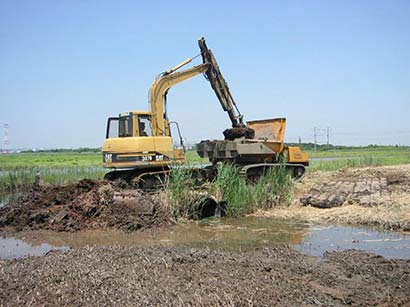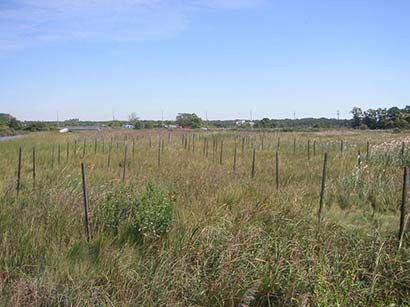Saw Mill Creek and the First NYC Wetlands Mitigation Bank

New York City is in the process of creating its first wetland mitigation bank in the marshlands surrounding Saw Mill Creek on Staten Island. Saw Mill Creek, a tributary to Prall’s Creek and the Arthur Kill, is encircled by the largest expanse of remaining salt marsh along Staten Island’s west shore. Historical filling and ditching practices, dumping, storm incursions and invasive species have severely degraded the wetlands and they no longer provide protection against storm surges or significant ecological habitats nor do they improve water quality. NYC agencies have joined forces in a pilot project that will restore the Saw Mill Creek wetlands and create wetlands mitigation credits for future projects.
What is a wetland mitigation bank?
A wetland mitigation bank is a wetland area that has been established, enhanced or restored and designated to compensate for future unavoidable conversions of wetlands during development activities at other sites. A value, or credits, is assigned to the wetland mitigation bank based on a stringent set of assessments of the ecological functions within the wetland. With regulatory approval, permittees can purchase credits from the bank to meet the requirements for compensatory mitigation on their own projects.
NYC has long had a love-hate relationship with its wetlands
The marshlands on the western side of Staten Island developed over 10,000 years ago during the recession of the last glaciers. As organic rich sediments and soils slowly accumulated in the marshlands, a rich and diverse habitat was created in the Sawmill Creek Area. Lenape Indians, and subsequently early European settlers, found the mudflats ideal for harvesting oysters and farming. However, with time and increasing pressure for developable land, the perception of wetlands changed significantly. Planners and developers thought of the wetlands as underutilized space and mosquito breeding grounds and went to great lengths to fill them. These efforts spanned from infilling and ditching at Saw Mill Creek to the creation, nearby, of the world’s largest landfill, Fresh Kills.
The 1970s saw the passage of a number of environmental laws as citizens and the government began to understand the negative impacts of humans on the earth. With the recognition that wetlands were being lost at a rapid pace, wetland protection and regulation was addressed in the Clean Water Act of 1977, as well as the NYS State Freshwater Wetlands Act of 1975 and Tidal Wetlands Act of 1977. These regulations were designed to preserve and protect the state’s diminishing wetlands and restore them wherever possible. However, early enforcement efforts were sporadic.
By the 1990s, with increased enforcement and more widespread development, developers were bumping up against wetland regulations more and more frequently. Construction in or near wetlands required lengthy studies, assessments of impacts, permitting and mitigation of impacts, all activities that while designed to protect wetlands, added uncertainty, time and cost to construction projects. And the new wetland areas being created to compensate for unavoidable impacts were often small, disconnected and poorly maintained. With such concerns in mind, federal agencies began creating guidance for the first mitigation bank in 1995. Now it’s big business, a $3 billion industry that is said to have restored 900,000 acres of wetlands at 1,800 bank sites across twenty-eight states.

How does a wetlands mitigation bank work?
A government agency, corporation, nonprofit organization, or other entity may create a bank under a formal agreement with a regulatory agency. Mitigation banks have four components:
- A bank site encompassing the wetlands being restored, established, or enhanced;
- A bank instrument or formal agreement between the bank owners and regulators establishing performance standards, management and monitoring requirements, and the terms of bank credit approval;
- An Interagency Review Team (IRT) that provides regulatory review, approval, and oversight of the bank; and
- A service area in which permitted impacts can be compensated for at a given bank.
The value of a bank is defined in “compensatory mitigation credits.” Each bank conducts an ecological assessment to determine and certify the number of credits it has available for sale. The bank retains the responsibility for the design, construction, monitoring, ecological success, and long-term protection of the new wetlands. The permittee only has to reimburse the bank for the cost of the credits which significantly streamlines the permitting requirements on their own projects.
NYC will restore about 68 acres of the Saw Mill Creek marshes at a cost of $14 million.
Current calculations indicate that the Saw Mill Creek restoration will create a bank of about 18 credits. The amount of money generated by the credits will depend on who they are sold to, private developers will have to pay for them, city agencies will not. But a review of the literature indicates that credit values can range from $20,000 to $200,000 and as high as $900,000 an acre and are getting more valuable as the market place matures. Ideally the credits from the Saw Mill Creek Mitigation Bank will bring a return that covers the cost of restoration. Once all the credits are sold, the bank will close while DPR will continue to monitor and maintain the restored wetlands.
There remain those who are concerned about mitigation banking in general and the Saw Mill Creek bank in particular. One of the biggest challenges is valuing the credits associated with a bank. Each wetland is different as is the demand for bank credits. Agencies use a number of ecological and environmental assessment techniques, and these are constantly being reevaluated and refined, but it is difficult to fully capture the economic value associated with natural resources.
Others have questioned whether the natural habitats and wetlands that took centuries to evolve can be artificially created and or restored in a span of just a few years. There is also the issue that banks are typically located in an area other than where the unavoidable impact has occurred and so by its nature cannot fully replicate the original wetland functions. In the extreme case of a wetland bank failure, the function of the original wetland is completely lost.
In the case of the Saw Mill Mitigation Bank there is also the concern of recontamination of the wetlands by waters from the Arthur Kill. The nearby waterway is heavily used by the shipping industry and has undoubtedly been contaminated by industrial uses on both its NJ and NY shores. The fear is that as the wetlands are restored, the constant contact with contaminated water will undermine the effectiveness of the restoration and the resulting quality of the wetland.
Those of us at nearby Freshkills Park as well as many developers, regulators and environmental organizations will be watching this pilot with great interest. Stay tuned for updates.




